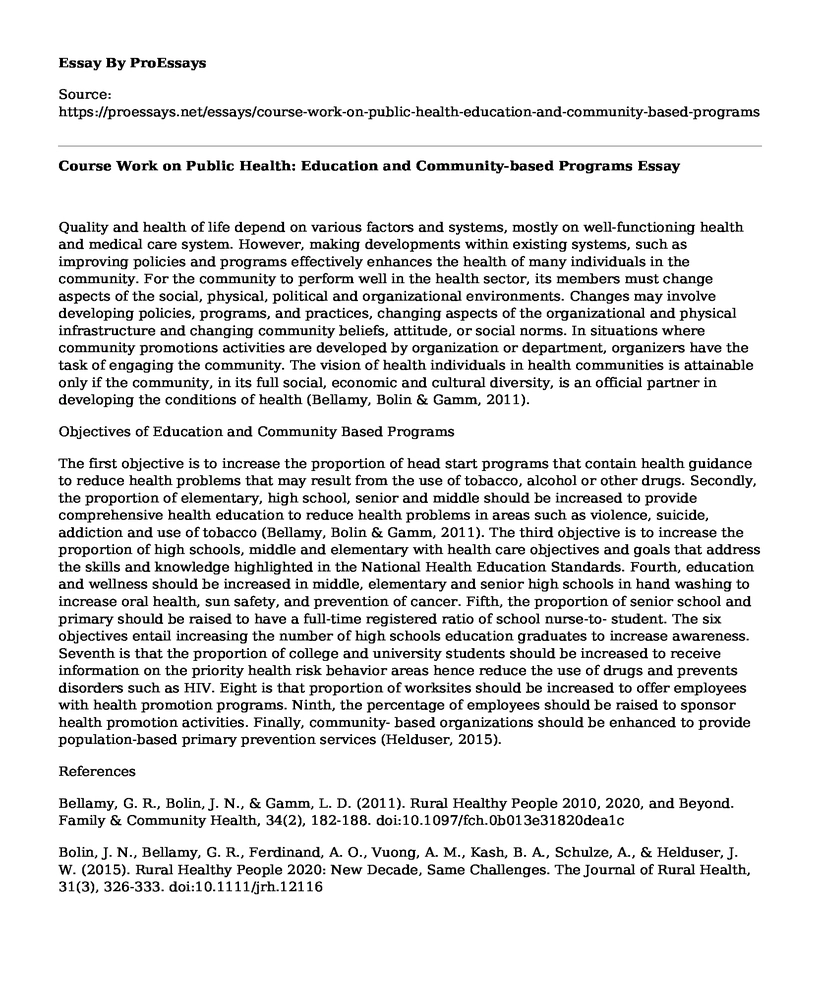Quality and health of life depend on various factors and systems, mostly on well-functioning health and medical care system. However, making developments within existing systems, such as improving policies and programs effectively enhances the health of many individuals in the community. For the community to perform well in the health sector, its members must change aspects of the social, physical, political and organizational environments. Changes may involve developing policies, programs, and practices, changing aspects of the organizational and physical infrastructure and changing community beliefs, attitude, or social norms. In situations where community promotions activities are developed by organization or department, organizers have the task of engaging the community. The vision of health individuals in health communities is attainable only if the community, in its full social, economic and cultural diversity, is an official partner in developing the conditions of health (Bellamy, Bolin & Gamm, 2011).
Objectives of Education and Community Based Programs
The first objective is to increase the proportion of head start programs that contain health guidance to reduce health problems that may result from the use of tobacco, alcohol or other drugs. Secondly, the proportion of elementary, high school, senior and middle should be increased to provide comprehensive health education to reduce health problems in areas such as violence, suicide, addiction and use of tobacco (Bellamy, Bolin & Gamm, 2011). The third objective is to increase the proportion of high schools, middle and elementary with health care objectives and goals that address the skills and knowledge highlighted in the National Health Education Standards. Fourth, education and wellness should be increased in middle, elementary and senior high schools in hand washing to increase oral health, sun safety, and prevention of cancer. Fifth, the proportion of senior school and primary should be raised to have a full-time registered ratio of school nurse-to- student. The six objectives entail increasing the number of high schools education graduates to increase awareness. Seventh is that the proportion of college and university students should be increased to receive information on the priority health risk behavior areas hence reduce the use of drugs and prevents disorders such as HIV. Eight is that proportion of worksites should be increased to offer employees with health promotion programs. Ninth, the percentage of employees should be raised to sponsor health promotion activities. Finally, community- based organizations should be enhanced to provide population-based primary prevention services (Helduser, 2015).
References
Bellamy, G. R., Bolin, J. N., & Gamm, L. D. (2011). Rural Healthy People 2010, 2020, and Beyond. Family & Community Health, 34(2), 182-188. doi:10.1097/fch.0b013e31820dea1c
Bolin, J. N., Bellamy, G. R., Ferdinand, A. O., Vuong, A. M., Kash, B. A., Schulze, A., & Helduser, J. W. (2015). Rural Healthy People 2020: New Decade, Same Challenges. The Journal of Rural Health, 31(3), 326-333. doi:10.1111/jrh.12116
Cite this page
Course Work on Public Health: Education and Community-based Programs. (2021, Apr 07). Retrieved from https://proessays.net/essays/course-work-on-public-health-education-and-community-based-programs
If you are the original author of this essay and no longer wish to have it published on the ProEssays website, please click below to request its removal:
- Health Informatics in Improving the Quality of Life Among Patients
- Argumentative Essay on Outdated Marriage
- Cancer Consideration Essay Example
- Essay Sample on Measuring GDP and Progress of Societies
- Child Development: Genes, Environment, and Play - Essay Sample
- Essay Sample on Older Adults in California: Challenges & Necessary Support
- Tolerance Through Forgiveness: Attitudes and Growing Together - Essay Sample







